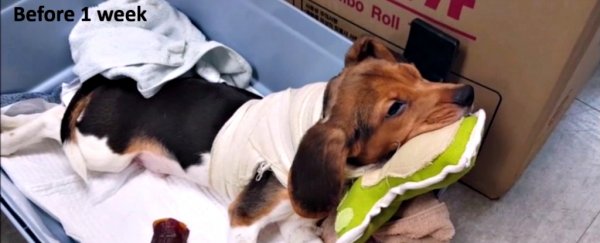The Italian neuroscientist who wants to try and preform the first human head transplant has co-edited a series of papers claiming to have conducted similar transplants on mice, rats, and a dog.
The papers, published in Surgical Neurology International, describe researchers in South Korea and the US using a chemical called polyethylene glycol, or PEG to help reconnect animals spinal cord.
The controversial neuroscientist behind the experiments, Sergio Canavero, rose to fame (or infamy depending on your take) back in 2015 when he proposed that human head transplants were possible, and something he wanted to undertake in a mere two years.
"The recipient's head is then moved onto the donor body and the two ends of the spinal cord – which resemble two densely packed bundles of spaghetti – are fused together," said Helen Thomson from New Scientist at the time.
"To achieve this, Canavero intends to flush the area with a chemical called polyethylene glycol, and follow up with several hours of injections of the same stuff. Just like hot water makes dry spaghetti stick together, polyethylene glycol encourages the fat in cell membranes to mesh."
But since then, honestly, the whole process has gotten pretty sketchy.
First there was the head transplant preformed on a monkey, which would have been awesome, but the press release came out with no paper backing it up, and so far, we can't see any papers scientifically demonstrating the process.
Plus the monkey was only kept alive for about 20 hours, so we only have photos to go off of at this point (NSFW though, they are pretty gruesome).
Despite the lack of solid evidence, a Russian man suffering from a degenerative disease has agreed to be the… headless guinea pig in this experiment, a hospital in Vietnam has said it's willing to make it happen, and there's a Chinese surgeon who has jumped on board as well.
The American team behind one of the latest papers, from the Rice University in Huston, Texas, worked towards making PEG more effective by adding graphene nanoribbons, which act as a scaffold for the neurons to grow onto.
"My motivation is spinal cord repair. If this works, it's going to have huge ramifications for spinal injuries," James Tour, who is part of the Rice team told Helen Thompson at New Scientist.
"But we thought, if you're going to be working towards a head transplant, you're going to need this, so let us help you."
The South Korean scientists involved, from Konkuk University, worked with the new type of PEG in five rats, although four of the five were killed in a flood in the lab so they could gather no results.
The final rat reportedly showed slight movement two days after the surgery, and within two weeks the rat was moving, standing on hind limbs and feeding itself.
Video footage shown to New Scientist last week appears to show the final South Korean experiment, with a dog walking three weeks after its spinal cord was almost completely severed.
The researchers said that after three days there was minimal movement, in two weeks it could walk with its front legs, and by three weeks it was walking normally.
But these papers still don't have scientists convinced.
"The dog is a case report, and you can't learn very much from a single animal without controls," says Jerry Silver, a neuroscientist in Ohio. "They claim they cut the cervical cord 90 per cent but there's no evidence of that in the paper, just some crude pictures."
"These papers do not support moving forward in humans," he added.
Either way, Canavero seems to be going full steam ahead, so, good or bad, we might see a human head transplant performed in 2017.
Hopefully it doesn't end up being as one scientist predicted, a fate "considerably worse than death".
You can read the papers online for the rat, mice, dog, and overall project at the Surgical Neurology International journal website.
The videos of the rat and dog post surgery are below.
